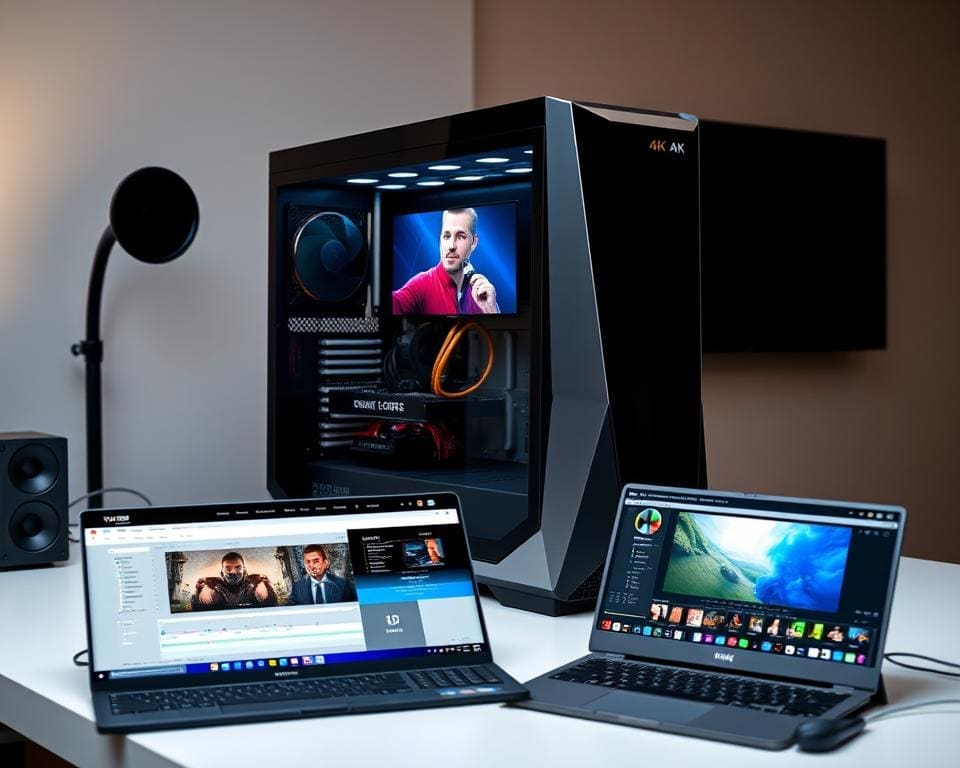As the demand for ultra-high-definition content continues to grow, understanding which computer is best for editing 4K video has become crucial for filmmakers and creators alike. Selecting the right video editing computers ensures that you possess the processing power and graphics capabilities to handle complex workflows effortlessly. A machine that can navigate through video playback and editing without lag not only enhances creative productivity but also prepares you for advanced software and techniques.
In this article, we will explore the important features and specifications that dictate what the best computer for video editing truly entails. From processor dynamics to the importance of graphics performance, we will guide you through everything you need to make an informed decision.
Understanding the Requirements for Video Editing
In the realm of 4K video editing, understanding the requirements is vital for achieving exceptional results. Selecting the right video editing hardware forms the foundation for an efficient workflow, enabling creativity to flourish without hindrance. Professionals need to focus not only on performance but also on the overall specifications that enhance the editing process.
Key Specifications for 4K Video Editing
To handle the intensive demands of 4K video editing, specific specifications stand out. A multi-core processor is essential, with options like Intel’s i7 or i9 and AMD’s Ryzen 7 or 9 delivering the necessary computational power. Alongside a powerful processor, adequate RAM is crucial. While 16 GB serves as a decent starting point for basic tasks, opting for 32 GB or more is wise when tackling extensive projects. Solid-state drives (SSDs) for storage complement these specifications, allowing for faster data access and significantly improving load times.
Importance of Graphics Performance
Graphics performance cannot be overlooked in the context of video editing. A robust graphics card, such as those from NVIDIA or AMD, plays a pivotal role in rendering high-resolution visuals quickly and efficiently. High-quality graphics performance allows editors to preview edits in real time, streamlining the editing process significantly. Investing in video editing hardware with superior graphics capabilities is essential for those aiming to elevate their craft and produce captivating content.

Which computer is best for editing 4K video?
Choosing the best computer for video editing, particularly for 4K content, relies on understanding performance needs and preferences. Numerous options cater to various budgets, making it essential to identify what works best for individual workflows. Apple’s MacBook Pro with the M1 chip stands out due to its renowned performance in video editing applications, delivering seamless editing experiences.
Another solid option lies with Microsoft’s Surface Studio, designed with a practical touchscreen interface and detailed display that enhances creative endeavours. For those leaning towards Windows, high-end 4K video editing PCs from renowned brands such as Dell and HP offer customisation options, empowering users to select powerful components tailored to their editing tasks.
When evaluating video editing computers, consider aspects such as processor speed, RAM capacity, and graphics performance. Each of these factors significantly impacts the overall editing experience, whether working on complex projects or simpler video tasks. By choosing wisely, creatives can enhance their output and workflow efficiency in 4K video production.
Best Computer Specs for Video Editing
When delving into the realm of video editing, understanding the best computer specs for video editing becomes crucial. High-quality video editing demands powerful hardware, ensuring smooth and efficient workflows. Two primary aspects to consider include the processor power and the memory configurations of your system.
Processor Power: What You Need
Processor performance holds a pivotal role in video editing. A powerful processor directly influences rendering speeds and overall efficiency. For optimal results, aim for at least a quad-core processor, yet octa-core options provide an even greater advantage, making them ideal for handling 4K video editing laptops. Multi-threading capabilities allow editors to multitask seamlessly, enhancing productivity without interruptions.
RAM and Storage Considerations
Memory and storage are equally vital. A minimum of 16GB of RAM is advisable for 4K video editing, ensuring that your system can effortlessly manage large files and complex projects. Opting for 32GB or more can considerably bolster performance, especially for professional editors. Regarding storage, SSDs are favoured due to their speed, significantly reducing load times and enhancing workflow efficiency. Combining SSD and HDD options can provide an effective solution for large media storage along with rapid access to project files.
Top Computers for Video Editing on the Market
When selecting the best computer for video editing, several models stand out due to their exceptional performance and durability. The right choice can significantly enhance your editing workflow and creativity, making it crucial to explore available options. A few standout computers showcase the pinnacle of video editing technology.
Highlighting Notable Models
Among the top computers for video editing, Apple’s MacBook Pro, especially the 16-inch model equipped with the M1 Pro chip, receives acclaim for its remarkable video editing capabilities. With powerful processing speed and extended battery life, it is a favourite among professional editors. Dell’s XPS 15 also impresses with its stunning display and robust performance, providing a perfect balance for video creators.
Comparing Performance and Value
When assessing the best computer for video editing, compare features such as RAM, graphics processing units, and storage options. NVIDIA’s Studio laptops are another excellent choice, offering potent graphics capabilities tailored for video editing tasks. Conducting a thorough comparison of performance metrics, along with pricing, will help you discover the ideal model that meets your specific needs without compromising your budget.
4K Video Editing Laptops: A Portable Solution
As the demand for high-quality video content continues to rise, the need for powerful yet portable solutions becomes paramount. 4K video editing laptops offer an ideal balance between performance and convenience, enabling creators to work on the go without sacrificing processing power. Advanced models, such as the Razer Blade Stealth and Lenovo ThinkPad X1 Extreme, exemplify how compact design can house remarkable capabilities, allowing users to edit videos with stunning clarity and speed.
These laptops are not merely tools; they are gateways to creativity. For anyone serious about video editing, investing in the right video editing computers means considering the specifications that maximise efficiency. A laptop equipped with a dedicated graphics card ensures smoother playback and faster rendering times, essential for editing 4K footage. Alongside this, ample RAM and efficient storage solutions can dramatically improve the workflow, making it feasible to handle large files effortlessly.
For creatives who thrive on flexibility, the portability of 4K video editing laptops opens doors to new environments. Whether working in a café or collaborating in a shared workspace, these laptops provide the necessary performance to maintain productivity without being tethered to a desk. Embracing innovative technology leads to enhanced creativity, echoing the sentiment that the right tools can inspire remarkable work.
4K Video Editing PCs: Desktop Advantages
For professionals in the world of video editing, the choice of computing equipment holds significant importance. While laptops offer portability, 4K video editing PCs provide advantages that cater to the demanding needs of video production members. This section highlights why desktops remain the preferred solution for creative experts.
Why Desktops Are Preferred by Professionals
4K video editing PCs deliver exceptional performance, greatly enhancing the editing process. One of the most compelling benefits lies in their expandability. Unlike laptops, these video editing computers allow users to increase memory, storage, or upgrade graphics cards to keep pace with rapidly evolving technology. This flexibility ensures that professionals can adapt their systems according to their specific requirements.
Another key factor is effective thermal management. High-performance desktops are built with advanced cooling systems, ensuring sustained performance during extensive editing sessions. While rendering complex video projects, these systems maintain optimal temperatures, preventing throttling and allowing for an uninterrupted creative flow. In summary, 4K video editing PCs are the cornerstone of successful video production, providing the reliability and power that professionals demand.
Video Editing Hardware You Can’t Ignore
When embarking on a journey through video editing, the right video editing hardware can truly transform the experience. Selecting quality peripherals ensures that the tools at hand enhance both efficiency and creativity. Essential components like monitors and external storage devices play pivotal roles in the editing workflow.
Displaying the Right Monitor
A high-quality monitor is fundamental for any video editor. Opt for a 4K monitor that delivers exceptional colour accuracy and high refresh rates. This combination allows you to view your edits with precision and clarity. The best computer specs for video editing often suggest monitors equipped with advanced panel technologies such as IPS or OLED, as these provide wider viewing angles and vibrant colours. Investing in a good display not only aids in achieving stunning visuals but also reduces eye strain during long editing sessions.
The Role of External Hard Drives
In the realm of video editing, storage solutions cannot be overlooked. External hard drives serve as vital tools for managing large files and ensuring smooth operations during editing projects. The best computer specs for video editing frequently include recommendations for SSDs due to their superior speed. This speed greatly enhances data transfer rates, making workflow seamless. Furthermore, maintaining backups on external drives adds an essential layer of security, safeguarding your creative work against potential data loss.
Factors to Consider Beyond Specs
When evaluating the best computer for video editing, it’s crucial to recognise that specifications are just one part of the equation. While impressive hardware can significantly enhance performance, understanding how your chosen software interacts with that hardware is equally essential. Different video editing applications, such as Adobe Premiere Pro, Final Cut Pro, or DaVinci Resolve, have unique demands and optimisations, which may affect your editing workflow. Therefore, ensure to verify compatibility with your preferred editing suite before making a choice.
Moreover, consider the importance of upgradability and future-proofing. As video editing software evolves, so too do the requirements for optimal performance. Selecting a computer with the potential for upgrades—such as additional RAM, improved graphics cards, or expanded storage—can save you from needing to invest in a new system sooner than anticipated. This foresight is particularly helpful in an industry that is constantly pushing the boundaries of high-definition content.
Lastly, think about the overall user experience. A computer that provides a smooth and seamless workflow can make a significant difference in your editing efficiency and creativity. Factors such as keyboard comfort, screen size, and thermal management might not be on the spec sheet, yet they greatly influence your productivity. Therefore, the best computer for video editing is one that not only meets technical specifications but also harmonises with your unique editing style and preferences.









